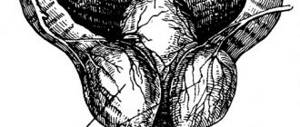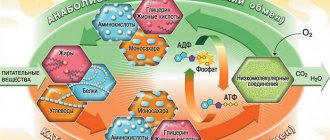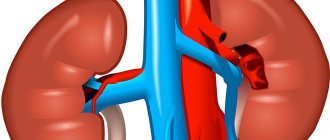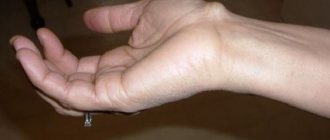What it is
The mammary gland is a structure of glandular epithelium and intermediate tissue - fat and connective fibers such as collagen and elastin. The tissue of this organ is very sensitive to hormonal influences, which can provoke inadequate growth of any structures.
Normally, when prolactin levels in the body increase, active milk synthesis begins and the breasts increase in size due to the growth of this special glandular layer. In pathology, fluctuations in the levels of estrogen and progesterone, as well as abnormal levels of prolactin, lead to mastopathy - benign growths in the mammary gland from various components of this organ. Fibroadenoma is formed when connective fibers are included in the growth and the formation of a more voluminous focus, lymphadenoma - when lymphatic ducts are involved, adenoma - from glandular cells and is small in size.
The tumor is small in size: from 1 to 3 centimeters, it is usually spherical, moderately dense and elastic to the touch, and easily moves with the surrounding tissues. Adenomas can be single or multiple, located on one or both sides. The growth of this formation occurs gently, displacing surrounding tissues without compression.
Forecast
The prognosis for breast adenoma is favorable . If the course is benign (this means that the tumor does not increase in size and complications do not develop), a woman can live with this pathology for many years.
If malignancy is suspected, a timely response from the doctor and a quick decision to perform surgical intervention are necessary - such tactics will help to avoid negative consequences.
Kovtonyuk Oksana Vladimirovna, medical observer, surgeon, consultant doctor
4, total, today
( 42 votes, average: 4.83 out of 5)
Breast contusion: causes, symptoms, treatment
Inverted nipples: correction and possible problems
Related Posts
Classification
The pathology is divided into nipple (or areola) adenoma and the breast tumor itself. The first option is divided into:
- ordinary - consists of multiple nodules of the cylindrical and myoepithelium, can become malignant;
- syringomatous - formed from elements of the sweat gland under the nipple area, the formation does not have clear boundaries.
In the mammary gland there are the following forms:
- fibrous or nodular - consists of connective tissue, denser and with clear edges;
- phylloid or leaf-shaped - has a lobed structure and is prone to active peripheral growth in “layers”, which is where it got its name;
- pericanalicular - comes from the connective tissue near the milk ducts;
- intracanalicular - formed from the epithelium of the milk ducts themselves, quickly leading to their blockage and inflammation;
- mixed - has characteristics of different forms.
This classification reflects the localization of the process and the nature of its growth. But according to the type of tissue that forms the compaction, the disease is divided into the following options:
- tubular tumor - consists of columnar epithelium with clear boundaries and densely arranged tubular cells;
- lactating - an epithelial formation that, during pregnancy and breastfeeding under the influence of hormones, begins to synthesize milk, usually formed from a tubular formation under the influence of hormonal levels;
- apocrine - consists of epithelium with an apocrine structure, similar in structure to tubular, sweat elements actively grow;
- ductal or ductal - comes from a duct, in the lumen of which a glandular or adenomatous polyp is formed, and the duct itself expands and increases in size;
- pleomorphic - consists of adipose, glandular and fibrous tissue, has a complex structure and can turn into carcinoma.
The last two types are quite rare; tubular or lactating adenoma is most often formed, especially during periods of sudden hormonal changes. Women may also develop variants such as fibrocystic adenoma, which is characterized by the formation of cavities - cysts with liquid contents and complex fibroadenoma (occupies an intermediate position between fibroma and adenoma).
Description of the disease
Breast adenoma is a disease in which pathological, abnormally rapid proliferation of cellular structures of glandular tissue occurs.
Pathological formations in the chest are a hard, elastic nodular compaction of a spherical, cylindrical, spherical shape. Neoplasms can be localized in one or both mammary glands. With strong magnification, their size is approximately 25-30 cm. In this case, women feel unpleasant painful sensations due to disruption of the innervation of the affected areas in the tissues.
In the case of adenoma, predominantly cellular structures and elements of fibrous and glandular tissues take part in its formation. They consist of the milky lobes, intralobular ducts, as well as nipples and the isola.
Benign tumors in the mammary gland can consist of single or multiple nodular neoplasms of various diameters. The disease has a benign course. Neoplasms are not prone to malignant degeneration, so they rarely provoke breast cancer. The development of breast adenoma occurs gradually and in the initial stages of development, pathological symptoms are mild or completely absent.
Most often, a benign tumor in the mammary glands is diagnosed in girls after 15 and before 29-33 years of age. At this age, active formation and development of the milky passages of the intralobular ducts occurs. This pathology often develops during menopause, during the premenopausal period, during breastfeeding, and pregnancy. The disease belongs to the group of benign mastopathy.
In medical practice, breast adenoma is detected less frequently than fibroadenoma, in which a benign pathological formation is formed from connective tissue, cellular structures of fibrous epithelium. It is a painless compaction. Fibrous tumors can be nodular or leafy.
Fibroadenomas are also noted in women after 35-40 years of age. At this age, glandular tissue is replaced by adipose and connective tissue, so breast adenoma is rarely diagnosed in older patients.
Causes
The development of such formations in the mammary glands is facilitated by hormonal factors: experts believe that an increase in estrogen levels with a decrease in progesterone can lead to the formation of adenomas. A sharp increase in prolactin also leads to this.
Specific reasons may be:
- taking hormonal contraceptives;
- abortion;
- birth of a child;
- breast-feeding;
- adnexitis, salpingoophoritis, endometritis;
- ovarian tumors;
- infectious and inflammatory diseases of the genitourinary system;
- prolonged stress;
- genetic predisposition;
- imbalance of progesterone and estrogen;
- smoking, alcohol abuse.
The formation of glandular tumors is also influenced by other endocrine glands, as well as the condition of the liver, where inactivation of sex hormones occurs. The development of the disease will be facilitated by the following factors:
- diabetes;
- obesity;
- metabolic syndrome;
- acute and chronic liver diseases;
- thyrotoxicosis or hypothyroidism;
- Cushing's disease or syndrome;
- taking steroid hormones.
Causes of the disease
Such a benign tumor in women is a type of mastopathy. It is predominantly diagnosed in females who are under 35 years of age. The neoplasm includes not only glandular tissue, but also stromal and fibrous tissue. In the vast majority of cases, the adenoma does not exceed three centimeters in size, but can grow up to 15 cm, which is life-threatening.
Clinicians consider hormonal imbalance to be the main factor influencing the formation of such formation; it is for this reason that pathology is most often detected during menstruation, pregnancy and breastfeeding. Quite rarely, a tumor appears in women during menopause.
In addition, the list of predisposing factors includes:
- violation of the secretion of sex hormones;
- dysfunction of the endocrine system, in particular the thyroid gland;
- genetic predisposition;
- malignant or benign ovarian tumors;
- diseases affecting the pancreas;
- uncontrolled use of hormonal contraceptives;
- premature cessation of breastfeeding or complete cessation of breastfeeding;
- presence of excess body weight;
- various liver diseases;
- termination of pregnancy by abortion;
- female infertility;
- long-term influence of stressful situations and depression;
- the presence in the medical history of chronic diseases of the female reproductive system;
- lack of sexual activity before age 30;
- long-term addiction to bad habits, namely smoking cigarettes.
In addition, frequent labor and painful menstruation, which in the medical field is also called dysmenorrhea, can contribute to the formation of breast adenoma.
Symptoms
Signs of the development of a benign process in the mammary gland depend on the form, variant, stage and course of the disease. In most cases, the adenoma does not manifest itself in any way and is asymptomatic; women do not feel that there is anything in the breast even upon palpation (feeling).
Sometimes a doctor can detect such a compaction during periodic preventive medical examinations: an adenoma is a dense, mobile, small and elastic formation of a round shape, which easily moves and does not cause discomfort in the patient. The surface of the tumor is smooth and the consistency is moderately hard, without any compaction. The size does not exceed 3 centimeters. The skin over the tumor is not changed, and the breast is not externally deformed. If the disease affects the nipple, then on the surface of the areola you can see a heterogeneous color and feel the different density of the nipple, the skin around it remains unchanged.
Over time, the process progresses, and the tumor manifests itself with the following symptoms:
- burning and tingling in the chest;
- dense crusts, ulcerations or cracks on the surface, especially in the nipple area;
- the formation of an “orange” peel in the areola area (a dangerous sign of possible malignancy);
- pain or discomfort when pressing and palpating;
- copious discharge of whitish or colorless liquid, milk or ichor;
- the tumor increases in size before the critical days and then decreases.
When to contact an oncologist
Often the process of neoplasms in the mammary gland remains unattended and women come to the doctor already with signs of oncology. Therefore, it is necessary to distinguish “good” from “evil” at an early stage. The fact that a tumor can be bad, cancerous, says:
- nipple retraction;
- changes in the skin over the tumor;
- the appearance of bloody or purulent discharge;
- symptom of “lemon peel”: the skin becomes dense, turns yellow and cracks, often in the area around the nipple;
- the formation is of different density to the touch, does not move, is fused to the skin;
- lymph nodes in the axillary region are enlarged;
- the formation is painful, causes a strong burning sensation;
- dimensions exceed 5-15 centimeters;
- there is no dynamics with hormonal changes during menstruation.
Symptoms of the disease
In the vast majority of cases, female breast adenoma is completely asymptomatic, which is due to the small volume of the tumor and often its slow growth. This means that very often it is a diagnostic surprise that is detected during a preventive examination by a mammologist.
When the adenoma reaches medium size, i.e. more than five centimeters, the main clinical sign will be the appearance of a small, elastic, spherical and mobile formation. It can be easily palpated independently, and it rarely causes pain.
It can increase in volume during menstruation or when carrying a baby, but after the end of a particular period it decreases again. It is noteworthy that cases have been recorded in which breast adenoma resolved on its own during pregnancy.
However, in some situations the following signs are present:
- pain and burning in the chest - such symptoms are often expressed with bilateral damage;
- slight redness of the skin over the tumor;
- change in the appearance of the breast - observed in cases of development of large tumors.
Symptoms of breast adenoma localized in the nipple or surrounding area:
- significant swelling;
- pathological redness of the skin;
- secretion of clear or serous fluid, less often - ichor, which leads to the formation of crusts;
- ulceration of the nipple surface;
- the appearance of a soft elastic node - easily detected during palpation;
- wrinkling of the skin surrounding the nipple of the left or right breast.
Symptoms of breast adenoma
Unlike a large number of other benign tumors, breast adenoma does not lead to an increase in the size of regional lymph nodes.
Diagnostics
To identify an adenoma in the mammary gland, you should consult a mammologist. During preventive medical examinations, a therapist may suspect something is wrong in the chest when palpating in a vertical and horizontal position. This will be the first stage of diagnosis. Subsequently, they carry out:
- ultrasound examination of the breast;
- mammography - x-ray of the breast with low-dose radiation;
- biopsy of a suspicious node (surgical or fine-needle under ultrasound guidance);
- microscopy and histology of the biopsy to determine the shape and variant;
- examination of regional lymph nodes if necessary (ultrasound, biopsy).
These examinations will allow you to verify an adenoma in the mammary gland. To search for possible causes and prevent further formations, you should do the following:
- Ultrasound of the pelvic organs;
- determine the levels of hormones - progesterone, estrogen, prolactin before and after menstruation, as well as in the middle of the cycle;
- vaginal smear for flora and cytology;
- general and biochemical blood tests (pay attention to protein, glucose, C-reactive protein, lipid spectrum, liver tests AST and ALAT);
- Ultrasound of the abdominal organs and retroperitoneal space.
Additional research methods for pathology in the breast include cytological examination of discharge from the mammary gland, magnetic resonance imaging of the breast to more accurately determine the structure and boundaries, ductography (x-ray contrast examination of the milk ducts), and MRI of the brain if a prolactin-producing tumor is suspected.
For timely diagnosis, all women under 45 years of age should undergo a diagnostic preventive examination with a mammologist once a year, since untimely detection is fraught with negative consequences.
How dangerous is the disease?
Such situations do not develop so often, but complications still occur:
- galactophoritis - inflammation of the milk ducts due to stagnation of secretions due to pressure, manifested by a syndrome of intoxication, pain, hyperemia and swelling of the mammary gland, compaction along the ducts;
- mastitis - inflammation of the breast tissue due to lactostasis, is the next stage after galactophoritis;
- abscess - a purulent complication of the inflammatory process, is an encapsulated cavity with inflammatory contents, the patient complains of severe and local pain in the chest, the temperature rises sharply;
- malignancy - malignancy, rare, symptoms are described above;
- breast deformation - large or multiple adenomas cause a change in the normal shape of the breast, especially after surgical removal of the formations.
Types of adenoma
Breast adenoma, depending on its location and characteristic features, has the following forms:
- tubular;
- lactating;
- apocrine;
- ductal
Also, in representatives of the fair half, neoplasms can be localized in the nipples and around the nipple area.
In the tubular form, the neoplasm is a small nodule formed from tubular elements. Adenomas in the breast typically consist of columnar epithelial cell structures. Other elements of the mammary glands may be involved in the pathological process.
With lactating adenoma, the formation of a dense small nodule is provoked by increased functional loads of the mammary glands during the period of feeding newborns. It is a tumor of the milk lobes. Formations can also form in the area of the excretory ducts. As a rule, neoplasms of this type resolve spontaneously after the end of the lactation period, after the hormonal levels in the body of women are normalized and restored.
With nipple adenoma, the appearance of formations in the peripapillary zone, a light, cloudy liquid is released from the nipple. Small red sores on the surface of the dermis are clearly visible. The dermis is slightly compacted.
Nodular neoplasms in the breast also include fibro-epithelial tumors, pleomorphic neoplasms, mixed, leaf-shaped fibroadenomas. This pathology has a wide variety of genesis and causes of development.
Treatment
Treatment of this disease consists of therapeutic and surgical methods. At the early stage of the disease, when the formation is no more than 1 cm and there is no further growth, drug therapy, as well as lifestyle correction, is sufficient. Changes in daily routine, nutrition, work and rest are necessary for a woman at any stage.
If the tumor reaches a large size, there is a tendency to increase, or there is a suspicion of oncology, then the node must be surgically removed and the biopsy specimen examined for histology.
General recommendations
For successful treatment of adenoma, a woman should:
- avoid stress and hypothermia;
- have regular sex life with a regular partner;
- protect yourself with barrier contraceptives;
- plan pregnancy to restore hormonal levels during a recurrent process;
- breastfeed your child for at least a year;
- use combined oral contraceptives only after examination and consultation with a doctor;
- once a year undergo an examination by a gynecologist, mammologist with palpation or ultrasound until the age of 45, and then a mammogram;
- take vitamins A, C, E and D in courses, and also monitor the condition of the liver;
- if necessary, use hepatoprotectors (Heptral, Karsil, Essentiale), as well as drugs that improve bile flow (ursodeoxycholic acid - Ursosan) after consultation and examination with a therapist;
- limit fatty, fried, flour, semi-finished products, enrich the diet with fruits and vegetables, maintain a drinking regime (1.5 liters of liquid per day);
- sleep at least 7-8 hours, avoid shift work;
- avoid termination of pregnancy.
Medicines
To restore hormonal levels, patients are prescribed combined preparations of estrogens and gestagens. If a woman has had her uterus removed, then estrogens alone can be used. Otherwise, there is a risk of proliferative formations of the endometrium.
Hormones are selected after studying the hormonal status. Therapy begins with low doses, treatment is carried out in courses. The gestagen component makes up 10-14 days of the cycle. You can use tablets orally, or you can use local forms: patches, gels.
Combined tablet forms are: Klimonorm, Femoston, Divina, Climodien, Angelique, Jess, Aktivel and others. Local options: Ovestin, Ornion, Estriol, Progestogel, Proginova. Apply to the skin of the abdomen, shoulders or back and allow to absorb for 2-3 minutes.
Hormonal therapy can cause complications in the heart (ischemic pain, blood pressure), blood (coagulopathies), and liver (cysts, increased enzymes). Therefore, before the appointment, it is necessary to examine the woman.
Herbal medicine with drugs containing natural estrogens from plants, as well as other components that help normalize hormonal levels: Remens, Mastodinon, Normomens, is considered milder. They are recommended to be taken long-term. To normalize the nervous system, sedatives and sedatives are used: Persen, Novopassit, Valerian, Afobazol.
Before menstruation and with severe pain and swelling in the chest, it is recommended to take decoctions of herbs with a diuretic effect: birch, dandelion, lingonberry, thyme, licorice root. You can use diuretics orally: torasemide, hypothiazide, indapamide.
Conservative treatment is carried out for a long time.
To monitor the effectiveness, an ultrasound is performed once a month, and they also monitor for possible side effects of the drugs. Hormonal medications can only be prescribed by a gynecologist after consultation with a mammologist.
Surgery
If the tumor enlarges and the previous approach is ineffective, removal of the adenoma is indicated. Depending on the size and course of the process, enucleation or sectoral resection is performed.
Enucleation is the “husking out” of the tumor within healthy tissue; this operation is minimally invasive. Sectoral resection is performed for large adenomas or suspected malignant process. Removal is carried out with an indentation of 1-3 centimeters into healthy tissue, thus the volume of removed material is larger, and the manipulation itself is larger. Often it leaves cosmetic defects on the chest.
These operations can be carried out in different ways:
1. Laser ablation: laser exposure without surgical access reduces the trauma of the operation, and a small formation is completely removed.
2. Cryogenic ablation: cold is applied to the lesion; incisions and removal are not required; it is also performed for small sizes.
3. Radio wave removal: an incision is made under local anesthesia, and radio waves are used to remove tissue, a softer and more gentle method of resection.
4. Classic intervention: access, incision and removal are made using a scalpel; depending on the scale, it can be performed under local or general anesthesia.
5. Ultrasound-guided biopsy: Used as an option for enucleation, an incision is made in the skin and a probe is inserted for aspiration and removal using a vacuum.
The postoperative rehabilitation period depends on the extent of the intervention and averages 1-2 weeks. At this time, you should be especially careful, and if stitches are placed, you should not get them wet or actively work the muscles in this area.
Treatment of breast adenoma
Treatment for breast adenoma can be:
- conservative;
- surgical.
Conservative prescriptions consist of regulating diet, sleep, rest - in order to equalize hormonal levels, the disturbances of which led to the development of the described pathology. Drug therapy is ineffective.
The only method of getting rid of breast adenoma is surgery. Indications for surgery are:
- an increase in the size of the adenoma, which is not associated with menstruation, pregnancy and lactation;
- the emergence of new nodes;
- suspicion of malignancy (malignant degeneration);
- the appearance of pain syndrome;
- pronounced cosmetic defect.
The method and scope of the operation depend on:
- size of breast adenoma;
- the course of the pathological process.
Types of surgical intervention can be the following:
- Enucleation is literally the removal of an adenomatous node from breast tissue. Indicated if there are no signs of malignant tumor degeneration;
- sectoral resection - removal of the adenomatous node along with surrounding tissues. When removed, approximately 1-3 cm of healthy tissue is captured. Indicated if there are signs of malignancy of the adenoma.
If a small tumor is desquamated, there is often no cosmetic defect. If large tumors are removed by enucleation or sectoral resection, a large defect in the breast tissue may form, to eliminate which it will be necessary to undergo plastic surgical correction.
Prevention
To avoid getting this disease you should:
- be regularly observed by gynecologists;
- properly manage pregnancy and breastfeeding;
- promptly diagnose genitourinary diseases;
- lead a healthy lifestyle;
- engage in physical activity and sports in moderation;
- avoid stress and emotional stress;
- eat fully and rationally;
- eliminate bad habits;
- have protected and regular sex;
- take hormones under the supervision of a doctor and do not self-medicate.
Treatment methods
Treatment for patients should be prescribed by the attending physician, having in hand the results of diagnostic studies. In the initial stages of pathology, with correctly selected, adequate treatment, the prognosis is, as is right, favorable. Often, benign tumors in the breast go away spontaneously, without drug therapy.
Therapeutic therapy, complex systematic treatment for breast adenoma is aimed at normalizing hormonal levels, adjusting, and reducing the concentration of sex hormones. Treatment is selected individually.
For the treatment of breast adenoma in the initial stages, if the size of the benign formation is within 3.5-4 cm, the tumors are painless, patients are prescribed symptomatic drug therapy. Conservative treatment methods with hormonal pharmacological drugs are used. Methylgesten, Ora-gest, Parlodel, Diferilin are prescribed.
If, based on the results of the biopsy, there are doubts about the nature of the tumor, the tumor is growing rapidly, disrupts the function of the gland, and if there is a tendency to malignancy, surgery is prescribed. Excision is performed under general or local anesthesia. The operation is also performed for cosmetic purposes if a pathological formation spoils the shape of the breast.
Removal of a benign tumor occurs by enucleation, as well as by sectoral resection. Enucleation is performed under local anesthesia. The rehabilitation period is short. The tumor is removed through a small incision in the skin made with a scalpel. The operation is accompanied by minimal trauma, but relapses are possible.
With sectoral resection, the breast adenoma is completely excised from the affected tissue. The operation is performed under general anesthesia. The neoplasm and nearby tissues in the affected area are captured. After surgery, patients are prescribed a course of hormonal therapy. Prescribe anti-inflammatory drugs, restorative medications to normalize the general condition (immunomodulators), vitamin and mineral complexes (vitamin A, B6, B12, E, C, P), preparations based on organic iodine, and homeopathic remedies.
If the size of the nodule exceeds 10-12 cm, women after treatment should constantly monitor their condition and visit a mammologist or endocrinologist.
In modern medicine, laser therapy and cryoblation are also used for breast adenoma. The treatment methods are absolutely painless and have a short recovery and rehabilitation period.
As an additional therapy, alternative medicine methods can be used simultaneously with drug treatment for breast adenoma. Tincture of walnut shells and herbal infusions that normalize the function of the liver, endocrine system, and gastrointestinal tract help well.
conclusions
Breast adenoma is a benign disease that often occurs in young women during hormonal imbalances. In many cases, the process occurs without symptoms, so you should be regularly monitored by a gynecologist and mammologist.
Adenoma rarely malignizes, but can cause inconvenience. The prognosis for this pathology is favorable. Treatment is carried out both medically and surgically. Removal is carried out in different ways depending on the prevalence. For comprehensive treatment and prevention, you need to follow recommendations for lifestyle changes.
Prevention and prognosis
To reduce the likelihood of developing breast adenoma, female representatives need to:
- completely give up bad habits;
- Avoid emotional stress if possible;
- use hormonal contraceptives correctly;
- engage in timely treatment of diseases of the liver, pancreas, as well as organs of the endocrine and reproductive systems;
- visit a mammologist and gynecologist several times a year for a preventive examination, which will make it possible to identify pathology in the early stages.
Since adenoma extremely rarely transforms into a malignant tumor, the prognosis of the disease is often favorable. Such a neoplasm is not an obstacle to conceiving a child or breastfeeding a baby.
If you think you have breast adenoma
and symptoms characteristic of this disease, then a mammologist can help you.
Source
Did you like the article? Share with friends on social networks:
Therapy methods
For breast adenoma, drug treatment has no positive effect. If the formation is small in size, dynamic observation is used. In some situations, surgery is required. Indications include: an increase in tumor size, the appearance of cosmetic defects, pain, suspicion of malignant degeneration.
Depending on the course of the disease and other associated factors, two types of treatment are possible:
- Enucleation. Removal of the tumor within healthy tissue. It can be performed using various cutting methods, as well as with additional cosmetic plastic surgery. The main contraindication is the risk of malignancy.
- Sectoral resection. A large-scale surgical operation during which the tumor is removed along with surrounding healthy tissues 1-3 cm in diameter. This method of surgical intervention is indicated for possible transition to a malignant tumor. After sectoral resection, cosmetic defects most often arise, which can be corrected by plastic surgery.
For nipple adenoma, surgical intervention is necessary. In this case, specialists can also resort to two types of operations - local excision and sectoral resection. Local excision - excision of the tumor and capture of healthy tissue within 1-2 mm from the edge of the formation.
Operations to remove adenoma are carried out as planned. After them, antibacterial therapy is prescribed for 7-10 days. Sutures are removed approximately one and a half weeks after surgery. Additional drug treatment is not required.












